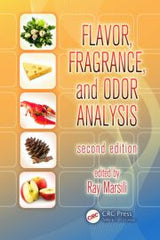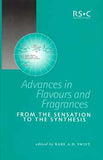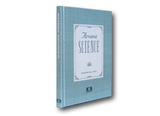Flavor, Fragrance, and Odor Analysis, Second Edition By Ray Marsili
Flavor, Fragrance, and Odor Analysis, Second Edition
Features
- Emphasizes SBSE techniques and discusses the significant advantage of this technique to flavor and odor studies
- Presents important updates on GC-olfactometry as a tool for studying flavor synergy effects
- Discusses how smelling multiple odor active compounds impacts odor and flavor perception
- Uses practical application examples of interest to flavor and odor researchers
Summary
There are many advantages to stir bar sorptive extraction (SBSE) for isolating and concentrating flavor-active chemicals from foods, including its simplicity and wide application appeal. Written from a practical, problem-solving perspective, the second edition of Flavor, Fragrance, and Odor Analysis highlights this powerful technique and emphasizes the range of applications available.
Topics discussed include
- Sequential SBSE, a novel extraction procedure
- A simplified method for switching from one-dimensional to two-dimensional GC-MS
- How analytical sensitivity and recovery of phenolic compounds can be improved using aqueous acylation prior to SBSE GC-MS
- Analyzing and combating off-flavors caused by metabolites from microorganisms
- A technique for measuring synergy effects between odorants
- The identification of the characterizing aroma-active compounds of tropical fruits with high economic potential
- The parameters utilized during the production of aqueous formulations rich in pyrazines
- How spectral deconvolution can be used to speciate the subtle differences in essential oil content and track key ingredients through the manufacturing process
The final chapter summarizes chemical identities of characterizing aroma chemicals in fruits, vegetables, nuts, herbs and spices, and savory and dairy flavors. It also provides a brief compendium of the characterization of off-flavors and taints that are reported in foods.
With contributions from a distinguished panel of international experts, this volume provides chemists and researchers with the latest techniques for analyzing and enhancing food flavor and fragrance.
Table of Contents
Sequential stir bar sorptive extraction; Nobuo Ochiai
Sequential stir bar sorptive extraction
Sequential SBSE with PDMS stir bar and EG Silicon stir bar
Selectable one-dimensional or two-dimensional gas chromatography–mass spectrometry; Nobuo Ochiai
Heart-cutting two-dimensional gas chromatography
Selectable one-dimensional or two-dimensional gas chromatography–mass spectrometry with simultaneous detection
Selectable one-dimensional or two-dimensional gas chromatography–olfactometry/mass spectrometry with preparative fraction collection
Simple derivatization prior to stir bar sorptive extraction to improve extraction efficiency and chromatography of hydrophilic analytes: Acylation of phenolic compounds; Ray Marsili
Determination of alkylphenols and bisphenol A in river water by stir bar sorptive extraction
Identification of smoke-taint chemicals in wine by SBSE GC–MS techniques
Determination of cresols in casein by SBSE GC–MS: Maximizing SBSE recovery with acylation
Analysis of musty microbial metabolites by stir bar sorptive extraction; Ray Marsili
Analytical approaches to monitoring nanogram-per-liter levels of musty metabolites
Stir bar sorptive extraction of geosmin in drinking water
Stir bar sorptive extraction of geosmin in salted snacks
Novel approach to collecting musty off-flavor compounds on tap
Haloanisole contamination of casein
Headspace sorptive extraction gas chromatography–time-of-flight mass spectrometry multivariate analysis for chemotaxonomic profiling of mold metabolites
The olfactometric analysis of milk volatiles with a novel gas chromatography-based method: A case study in synergistic perception of aroma compounds; Yvette Naudé and Egmont R. Rohwer
Sorptive extraction
High-capacity headspace sorptive extraction of aroma compounds from milk followed by TDS-CIS-GC–FID
Novel heart-cutting fraction collection GC-based methods
Off-line olfactory evaluation of single compounds and their combinations
Slow release of the aroma of single compounds captured by GCFC on individual secondary MCTs
Characterizing aroma-active volatile compounds of tropical fruits; Patricio R. Lozano
Tropical fruits and their health benefits
Flavor characterization of tropical fruits: Free volatiles and glycosidically bound volatiles—A dynamic scenario
Isolation of aroma chemicals
Contribution of aroma compounds to flavor
Main aroma compounds of some exotic tropical fruits
Mango
Passion fruit
Guava
Kiwi
Lychee
Rambutan
Pineapple
Papaya
Araca-boi
Acerola
Soursop
Babaco
Naranjilla
On the synthesis and characteristics of aqueous formulations rich in pyrazines; William M. Coleman, III
Materials and methods
Sample preparation
Results and discussion
Model reactions
Using automated sequential two-dimensional gas chromatography/mass spectrometry to produce a library of essential oil compounds and track their presence in gin, based on spectral deconvolution software; Albert Robbat, Jr. and Amanda Kowalsick
Experimental
Results and discussion
Character-impact flavor and off-flavor compounds in foods; Robert J. McGorrin
Character-impact flavors in foods
Characterizing aromas in off-flavors
Index
Editor Bio(s)
Ray Marsili has published over 30 papers on food and flavor chemistry in refereed chemistry journals, as well as over 100 technical papers for trade publications and numerous chapters for flavor chemistry and dairy chemistry books. He served as a contributing editor of Food Product Design magazine, editor of R&D magazine's Sample Preparation Newsletter, and lecturer in organic chemistry at Rock Valley College, Rockford, Illinois. He has edited two previous books on flavor and odor analysis: Techniques for Analyzing Food Aroma (1997) and Flavor, Fragrance and Odor Analysis (2002). He has over 30-years' experience as an R&D analytical laboratory manager/flavor chemist for major national and international food and ingredient companies. Today, he is an independent analytical flavor consultant, with a laboratory at Rockford College, Rockford.


















